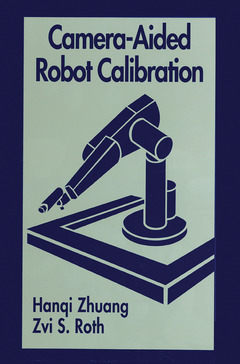Camera-Aided Robot Calibration
Auteurs : Zhuang Hangi, Roth Zvi S.

Robot calibration is the process of enhancing the accuracy of a robot by modifying its control software. This book provides a comprehensive treatment of the theory and implementation of robot calibration using computer vision technology. It is the only book to cover the entire process of vision-based robot calibration, including kinematic modeling, camera calibration, pose measurement, error parameter identification, and compensation.
The book starts with an overview of available techniques for robot calibration, with an emphasis on vision-based techniques. It then describes various robot-camera systems. Since cameras are used as major measuring devices, camera calibration techniques are reviewed.
Camera-Aided Robot Calibration studies the properties of kinematic modeling techniques that are suitable for robot calibration. It summarizes the well-known Denavit-Hartenberg (D-H) modeling convention and indicates the drawbacks of the D-H model for robot calibration. The book develops the Complete and Parametrically Continuous (CPC) model and the modified CPC model, that overcome the D-H model singularities. The error models based on these robot kinematic modeling conventions are presented.
No other book available addresses the important, practical issue of hand/eye calibration. This book summarizes current research developments and demonstrates the pros and cons of various approaches in this area. The book discusses in detail the final stage of robot calibration - accuracy compensation - using the identified kinematic error parameters. It offers accuracy compensation algorithms, including the intuitive task-point redefinition and inverse-Jacobian algorithms and more advanced algorithms based on optimal control theory, which are particularly attractive for highly redundant manipulators.
Camera-Aided Robot Calibration defines performance indices that are designed for off-line, optimal selection of measurement configurations. It then describes three approaches: closed-form, gradient-based, and statistical optimization. The included case study presents experimental results that were obtained by calibrating common industrial robots. Different stages of operation are detailed, illustrating the applicability of the suggested techniques for robot calibration. Appendices provide readers with preliminary materials for easier comprehension of the subject matter. Camera-Aided Robot Calibration is a must-have reference for researchers and practicing engineers-the only one with all the information!
Introduction. Camera Calibration. Kinematic Modeling for Robot Calibration. Pose Measurement with Cameras. Error-Model-Based Kinematic Identification. Kinematic Identification: Linear Solution Approaches. Simultaneous Calibration of a Robot and a Hand-Mounted Camera. Robotic Hand/Eye Calibration. Robotic Base Calibration. Simultaneous Calibration of Robotic Base and Tool. Robot Accuracy Compensation. Selection of Robot Measurement Configurations. Practical Considerations and Case Studies. References. Appendices. Index.
OTIs: 7981, 4468, 4457
Date de parution : 06-2020
15.6x23.4 cm
Thèmes de Camera-Aided Robot Calibration :
Mots-clés :
Calibration Board; Pose Errors; Robot End Effector; Orientation Errors; Positioning Errors; Pose Measurement; Camera Calibration; Joint Axis; World Coordinates; Robot Configuration; World Coordinate System; Error Parameter Vector; Quaternion Algebra; Camera Coordinate System; End Effector Poses; Kinematic Parameters; Tool Frame; Kinematic Model; Eye Calibration; Prismatic Joints; Revolute Joint; Tool Coordinate Systems; Calibration Point; Robot Pose; Robot Hand
